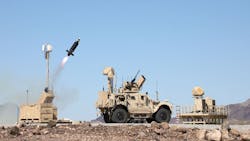LIDS Defense Systems Guard Against Drones
Rapidly growing numbers of unmanned aircraft systems (UAS) or drones are posing increasingly robotic threat environments in the battlespace, prompting the need for the U.S. Army’s Low Integrated Defeat System (LIDS). It's a counter-UAS response that provides an effective defense against armed and surveillance unmanned aerial vehicles (UAVs).
The system is implemented with the Ku-band radar and Coyote effector systems from Raytheon. The radar provides 360-degree threat detection while the Coyote systems are low-cost defensive solutions for enemy UAS attacks. The LIDS defensive systems are used in mobile and fixed-site operations (see image above) in support of the Army’s Central Command operations.
The Army integrates the radar and effector systems with the Forward Area Air Defense Command and Control system, or (FAADC2) from Northrop Grumman and the electronic-warfare (EW) system from Syracuse Research Corp. to create an integrated LIDS counter-UAS solution.
LIDS can be deployed as a mobile or fixed system for flexibility. Because of the growing complexity of on-board UAS devices and the increasing number of drones in the battle place, a multiple-systems solution is required to detect and guard against the stealth and agility of UAS surveillance and weaponry. The UAS vehicles range in size from small quadcopters to larger cruise-missile-type aircraft.
Bill Darnè, Raytheon’s Requirements and Capabilities director for counter-UAS capabilities, explained, “There are other kinds of counter-UAS configurations, but LIDS is the most robust in everything from detect, track, identify, and defeat. That’s the advantage Coyote and KuRFS bring to the LIDS configuration. It’s been rigorously tested, deployed in theater, and getting the job done.”
About the Author
Jack Browne
Technical Contributor
Jack Browne, Technical Contributor, has worked in technical publishing for over 30 years. He managed the content and production of three technical journals while at the American Institute of Physics, including Medical Physics and the Journal of Vacuum Science & Technology. He has been a Publisher and Editor for Penton Media, started the firm’s Wireless Symposium & Exhibition trade show in 1993, and currently serves as Technical Contributor for that company's Microwaves & RF magazine. Browne, who holds a BS in Mathematics from City College of New York and BA degrees in English and Philosophy from Fordham University, is a member of the IEEE.
